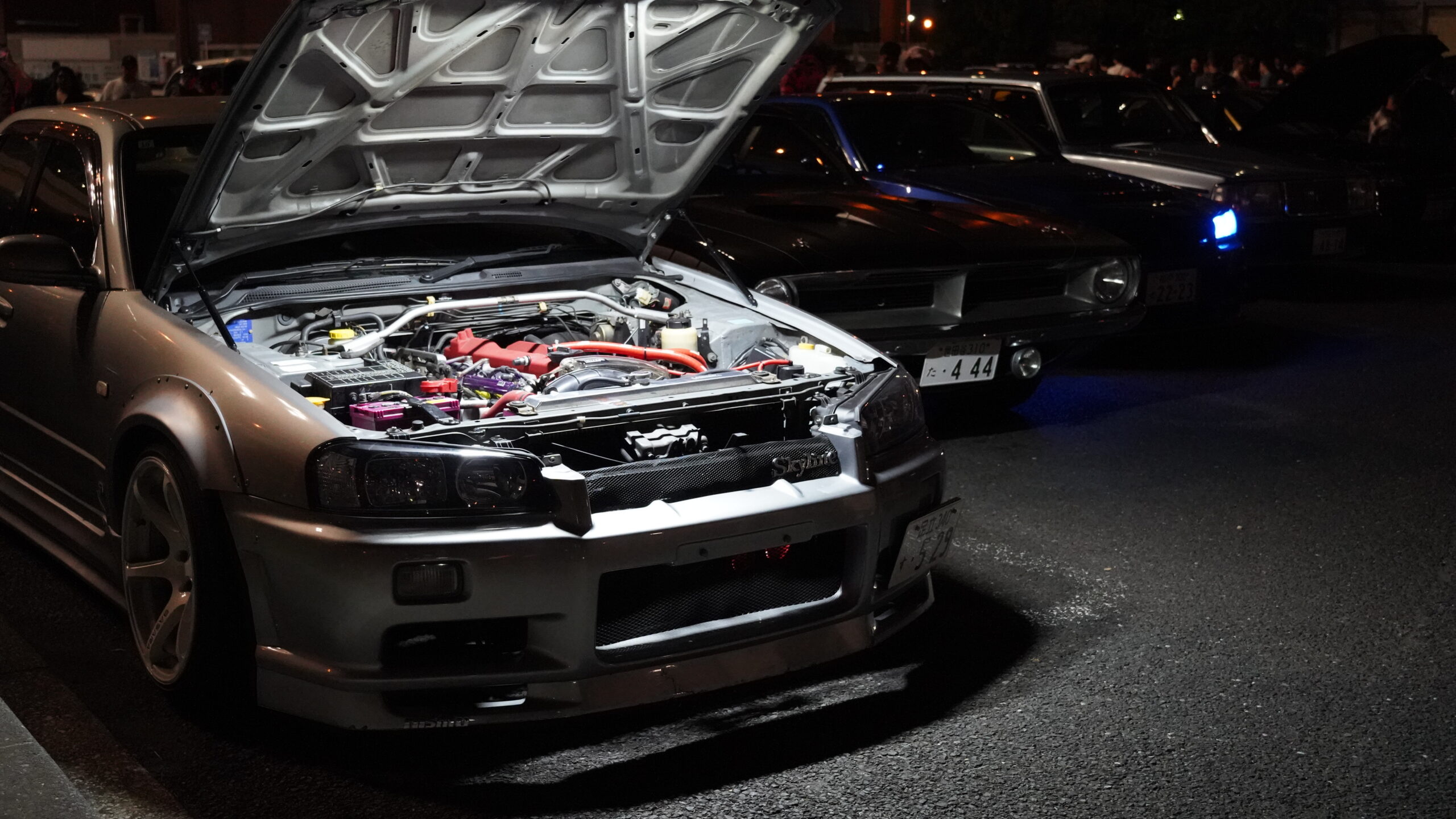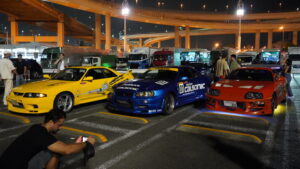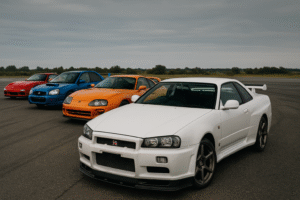Introduction — Why JDM Engines Captured the World’s Heart
Among all the wonders to emerge from Japan’s golden age of automotive engineering, none shine brighter than its JDM engines.
From screaming naturally aspirated fours to iron-block turbo sixes and even a dignified V12, these powerplants became cultural icons — the heart and soul of Japan’s mechanical artistry.
An engine defines a car’s character. It’s the link between human and machine, where sound, vibration, and response create emotion.
Even a modest chassis becomes thrilling with the right engine, while a great car can feel lifeless without one.
This feature pays tribute to seven of the most legendary JDM engines ever built, chosen for their blend of performance, durability, innovation, motorsport heritage, and emotional resonance.
Each of them tells a story — not just of engineering, but of obsession, competition, and the pursuit of perfection that shaped the JDM world.
Mitsubishi 4G63 Turbo
The Iron-Block Warrior That Battled Subaru for WRC Supremacy
Few rivalries defined the 1990s like Mitsubishi vs. Subaru, and at the center of that fight roared the 4G63 Turbo — the beating heart of the Lancer Evolution.
Debuting in the late 1980s, this 2.0-liter inline-four turbo became synonymous with rally warfare.
Its cast-iron block made it heavier than Subaru’s aluminum boxer, but also nearly indestructible.
Tuners quickly discovered its appetite for boost: 400, 500, even 600 horsepower on factory internals wasn’t uncommon.
Its long-stroke design delivered muscular torque right off the line, ideal for gravel and tarmac rally stages.
In WRC competition, it powered Tommi Mäkinen’s Evos to multiple victories and a Manufacturers’ Championship, proving Japan could take on Europe’s best.
Decades later, the 4G63 remains a hero of the tuning scene — a symbol of raw mechanical strength and JDM grit that refuses to die.
Toyota 1GZ-FE
The Silent Majesty of the Only JDM V12
In a world obsessed with power and noise, Toyota’s 1GZ-FE took the opposite path.
Built exclusively for the Toyota Century, it is the only V12 ever produced for a JDM car, a masterpiece of refinement over raw aggression.
Each bank of six cylinders operates on its own ECU, allowing the engine to limp home even if one side fails — an engineering philosophy rooted in reliability and grace.
Its combustion balance is perfect; its idle is whisper-quiet.
The experience is less an exhaust note and more a heartbeat, pulsing beneath layers of silence.
The 1GZ-FE’s role was never about lap times. It embodied dignity, craftsmanship, and mechanical serenity, created for Japan’s emperors and executives.
It remains a symbol of Toyota’s ability to combine humility and perfection — a zen approach to power found only in true JDM luxury.
Subaru EJ20 Turbo
The Boxer That Made Subaru a WRC Legend
First launched in 1989, the EJ20 became Subaru’s signature engine for three decades.
This 2.0-liter horizontally opposed boxer turbo powered icons like the Impreza WRX STI, defining the brand’s DNA and the sound of an era.
The design offered a low center of gravity and inherent balance, perfect for Subaru’s symmetrical AWD system.
With Japan’s voluntary limit of 280 PS, the EJ20’s real-world performance was far beyond its paper specs.
Under the hands of Colin McRae, Richard Burns, and Petter Solberg, EJ20-powered cars conquered the World Rally Championship, bringing the Subaru name to global fame.
Its burbling exhaust note — the famous “boxer rumble” — became a cultural trademark across the JDM world.
Even after production ended in 2020, the EJ20 remains a symbol of JDM authenticity and motorsport heritage, a bridge between engineering precision and driver passion.
Mazda 13B Rotary
The Tiny Engine with an Infinite Soul
If any engine defines Japan’s spirit of innovation, it’s Mazda’s 13B rotary.
Compact, unconventional, and utterly unique, this twin-rotor 1.3-liter unit (654 cc × 2) produced up to 280 PS in the RX-7 FD3S, while weighing less than most inline-fours.
Instead of pistons, it used triangular rotors spinning inside an epitrochoid housing — producing seamless power delivery and a haunting, high-revving tone.
The 13B’s compactness allowed Mazda to mount it low and rearward, creating the RX-7’s near-perfect balance and legendary agility.
In 1991, the four-rotor R26B — a direct descendant of the 13B — propelled the Mazda 787B to victory at Le Mans, marking the first and only overall win for a JDM manufacturer.
That moment immortalized the rotary as an engine of genius and courage.
Though emissions laws silenced it, enthusiasts worldwide still celebrate the 13B’s purity — proof that true JDM innovation values soul over conformity.
Honda F20C VTEC
The Naturally Aspirated 9000 rpm Miracle
Honda’s F20C, built exclusively for the S2000, redefined what a naturally aspirated engine could be.
With 125 horsepower per liter and a screaming 9000 rpm redline, it was the most intense 2.0-liter engine of its time — and still one of the most beloved.
Its lightweight forged internals, fiber-reinforced pistons, and VTEC variable valve timing allowed two personalities in one block: smooth and docile below 6,000 rpm, explosive and feral above it.
The sound transformed from hum to race-car howl, encouraging drivers to chase the redline every chance they got.
More than performance, the F20C embodied Honda’s racing ethos — precision, balance, and emotional connection.
It wasn’t just an engine; it was an invitation to drive better, to engage fully with every shift and every millisecond.
Even today, the F20C remains the reference point for naturally aspirated JDM perfection.
Toyota 2JZ-GTE
The Indestructible Straight-Six That Ruled the Tuning World
Say the words “2JZ” and any car enthusiast will smile.
This 3.0-liter twin-turbo inline-six from the Toyota Supra (JZA80) is perhaps the most famous JDM engine ever among tuners worldwide.
Factory-rated at 280 PS under Japan’s “gentlemen’s agreement,” its true power potential was monstrous.
With a cast-iron block, forged internals, and robust oiling system, the 2JZ could withstand unimaginable abuse — reliably producing 1,000 hp or more with proper upgrades.
The result was global domination: Supras setting quarter-mile records, drift cars breathing flames, and street builds earning legendary status.
Its smoothness, tunability, and resilience turned it into the ultimate canvas for performance art.
Thanks to films like The Fast and the Furious, the 2JZ became a symbol of JDM tuning culture itself — an engine that blended Japanese precision with brute force.
It remains the gold standard of reliability and mod-friendly power.
Nissan RB26DETT
The Heart of Godzilla — The Engine That Built a Dynasty
Crowning this list is the Nissan RB26DETT, the twin-turbo inline-six that powered the legendary Skyline GT-R (R32–R34).
Developed explicitly to dominate Group A racing, it became the beating heart of “Godzilla,” Japan’s most feared performance car.
The RB26 featured six independent throttle bodies, a strong iron block, and twin parallel turbos.
Officially limited to 280 PS, its real output hovered near 320 PS — and its tuning headroom extended far beyond.
Properly built RB26s can produce 1,000 horsepower while maintaining that signature silky-smooth straight-six note.
On track, it crushed everything in its path, securing over 29 consecutive victories in Japanese touring car competition.
Its combination of strength, precision, and personality made it the ultimate symbol of JDM performance.
To this day, the RB26DETT represents the soul of the GT-R legend — not just an engine, but an identity.
Honorable Mention — Honda B18C
The Engine That Defined Type R Purity
Before the F20C, there was the B18C — the 1.8-liter VTEC inline-four that powered the Integra Type R (DC2).
Producing over 100 hp per liter in the mid-1990s, it was a naturally aspirated marvel of precision.
Hand-polished intake ports, perfectly balanced crank, and a wild VTEC crossover made every drive an event.
It was small, light, and ferociously alive — delivering a sense of connection that remains unmatched.
The B18C exemplified the lightweight purity at the heart of JDM philosophy: performance through simplicity.
Comparative Table — Icons of the JDM Engines Era
| Rank | Engine | Layout | Displacement | Aspiration | Factory Output | Key Models | Defining Traits |
|---|---|---|---|---|---|---|---|
| 1️⃣ | Nissan RB26DETT | Inline-6 Twin Turbo | 2.6 L | Turbocharged | 280–320 PS | Skyline GT-R (R32-R34) | Godzilla’s heart; limitless tuning; Group A champion |
| 2️⃣ | Toyota 2JZ-GTE | Inline-6 Twin Turbo | 3.0 L | Turbocharged | 280 PS | Supra JZA80, Aristo | Indestructible iron block; global tuning icon |
| 3️⃣ | Honda F20C | Inline-4 NA | 2.0 L | Naturally Aspirated | 250 PS @ 8,300 rpm | S2000 | 9000 rpm redline; razor throttle; 125 hp/L |
| 4️⃣ | Mazda 13B-REW | Twin Rotor | 1.3 L | Twin Turbo | 280 PS | RX-7 FD3S | Lightweight; rotary uniqueness; Le Mans heritage |
| 5️⃣ | Subaru EJ20 | Flat-4 Turbo | 2.0 L | Turbocharged | 280 PS | Impreza WRX STI | Boxer rumble; WRC titles; balance & stability |
| 6️⃣ | Toyota 1GZ-FE | V12 NA | 5.0 L | Naturally Aspirated | 280 PS | Toyota Century | Only JDM V12; supreme refinement & craft |
| 7️⃣ | Mitsubishi 4G63 | Inline-4 Turbo | 2.0 L | Turbocharged | 280 PS | Lancer Evolution | Rally heritage; iron-block durability |
| 🏅 | Honda B18C (HM) | Inline-4 NA | 1.8 L | Naturally Aspirated | 200 PS | Integra Type R (DC2) | VTEC purity; lightweight precision |
Conclusion — The Soul of the JDM Era
From the shriek of a Honda VTEC at 9000 rpm to the burble of a Subaru boxer, from the turbine whine of a Supra to the whisper of a Toyota V12 — these JDM engines are far more than mechanical assemblies.
They are emotional instruments that turned metal into music.
Each represents a different chapter of Japan’s identity:
- Innovation and risk-taking — Mazda’s rotary defying convention
- Discipline and precision — Honda’s VTEC masterpieces
- Strength and endurance — Nissan and Toyota’s iron-block sixes
- Balance and control — Subaru’s boxer symmetry
- Elegance and craftsmanship — Toyota’s serene V12
As the world transitions toward electrification, enthusiasts still look back to these engines as the benchmark of mechanical emotion.
They remind us that a machine can have a heartbeat, that engineering can express art, and that the JDM legacy is not just about power — it’s about passion, individuality, and soul.
The future may hum in silence, but the past will always roar — and in that roar lives the everlasting spirit of JDM.





